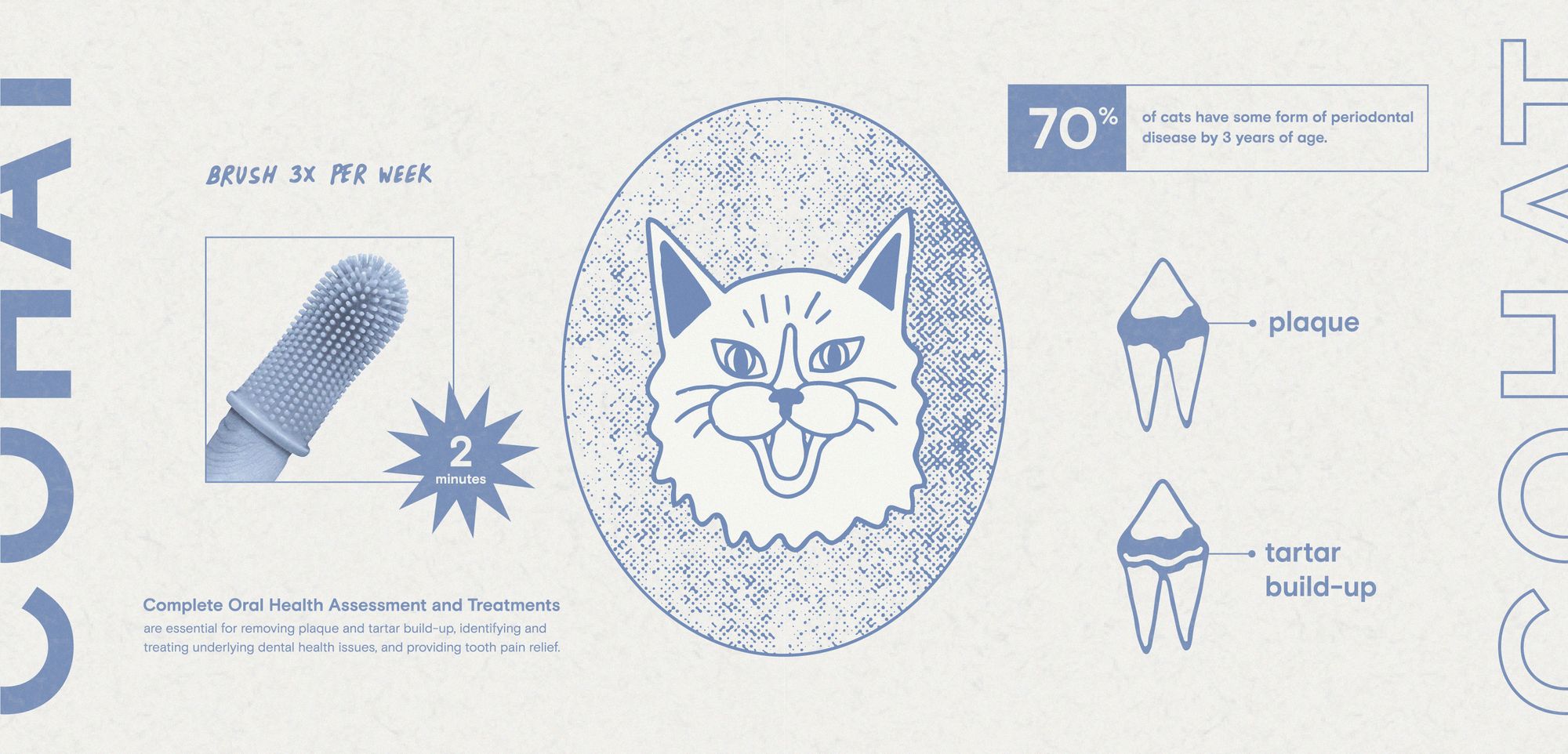Ask Dr. Aberman: Do I Have to Brush My Cat's Teeth?
The answer is yes! But there’s a catch: it’s also important to take your cat in for a regular Complete Oral Health Assessment and Treatment (COHAT).

Hey, friend! 👋 I’m Dr. Vanessa Aberman, Director of Medical Quality at Modern Animal. In my time as a practicing veterinarian, I’ve been asked a lot of questions about caring for cats’ teeth. One that comes up frequently is whether or not you should brush on a regular basis. In short, the answer is yes, but there’s a catch. It’s also important to take your cat in for a regular COHAT (a fancy acronym for dental cleanings under general anesthesia that stands for 'Complete Oral Health Assessment and Treatments'), to prevent their dental health from deteriorating. I’ll get more into this below.👇
To Brush or Not to Brush?
Just like with humans, good dental health is important for cats. When a cat’s dental health deteriorates, bacteria and plaque can build up, leading to gum disease and tooth decay. Gum disease, in turn, can contribute to health problems like kidney disease and heart disease. While brushing your cat's teeth is a great way to maintain their oral health at home, it's unfortunately not always enough.

10 Common Questions About Brushing Your Cat’s Teeth
1. Why should I brush my cat’s teeth?
Not so fun fact: by three years of age, 70% of cats have some form of periodontal disease (🤯), which is caused by bacterial plaque and tartar buildup on the teeth that leads to inflammation and infection of the gums and surrounding tissue. As periodontal disease worsens, it can lead to tooth loss and jawbone damage (ouch).
2. How often should I brush their teeth?
Brush your cat’s teeth at least three times per week to prevent plaque and tartar build-up along the gumline. This frequency will make routine dental cleaning easier (and less painful, too).
3. How long should I brush their teeth?
You should aim to brush your cat's teeth for at least two minutes per session. It's recommended to start brushing their teeth with a very short session (only a few seconds) and then gradually increase the time.
4. What is the proper way to brush their teeth?
Hold your cat's head still and using the fingers of that hand, gently raise the lip. Then, use circular motions near their gum line, and gently brush front to back, covering all of their teeth. Make sure to reward them with treats or praise after brushing to make the experience positive.
5. Which toothbrush do you recommend?
Use a toothbrush that is specifically designed for cats. These toothbrushes typically have smaller heads and softer bristles than toothbrushes for humans. One popular type of toothbrush is a finger brush, which is worn on the finger like a thimble and has soft bristles on the top to clean the teeth and gums. This type of brush can be easier for you to use and can be less intimidating for your cat.
6. Is it okay to use human toothpaste?
No 🙅. You should never use human toothpaste on a cat. It contains fluoride, which is toxic to them.
7. Which toothpaste do you recommend?
I recommend using a toothpaste specifically formulated for cats, such as Virbac’s C.E.T. Enzymatic Toothpaste. These products are flavored with chicken or seafood to make them more appealing. If your cat dislikes the taste, you can mechanically brush their teeth using a non-flavored toothpaste.
8. My cat is skittish. How do I make brushing their teeth easier?
Totally get it. It's important to get your cat used to having its teeth touched. You can start by gently rubbing your finger along their gums and teeth. Gradually increase the amount of time you spend on this activity and they will become more comfortable with the process.
9. Should I wear gloves while brushing their teeth?
Wearing gloves while brushing your cat's teeth is not necessary, but you can if it makes you more comfortable.
10. My cat’s gums bleed when brushed. Should I be worried?
If your cat has sensitive gums, you may need to adjust your brushing technique or use a softer toothbrush. Bleeding gums can be a sign of periodontal disease and should be evaluated. Consult with a veterinarian for further advice on how to care for your cat’s dental health.
What's the Deal With Anesthesia-Free Cleanings?
I’d steer clear of anesthesia-free dental cleanings because they are simply ineffective at preventing and treating underlying dental health issues that us doctors typically find. These dental cleanings do not include a thorough oral examination, cleaning, X-rays, and other diagnostic tools. As a result, they do not address the root cause of tooth pain by treating diseased or damaged teeth.
The Bottom Line
I recommend tooth brushing at least three times per week in conjunction with a COHAT every 6 to 12 months (depending on your cat’s oral health track record), which are essential for removing plaque and tartar build-up, identifying and treating underlying dental health issues, and providing tooth pain relief.
